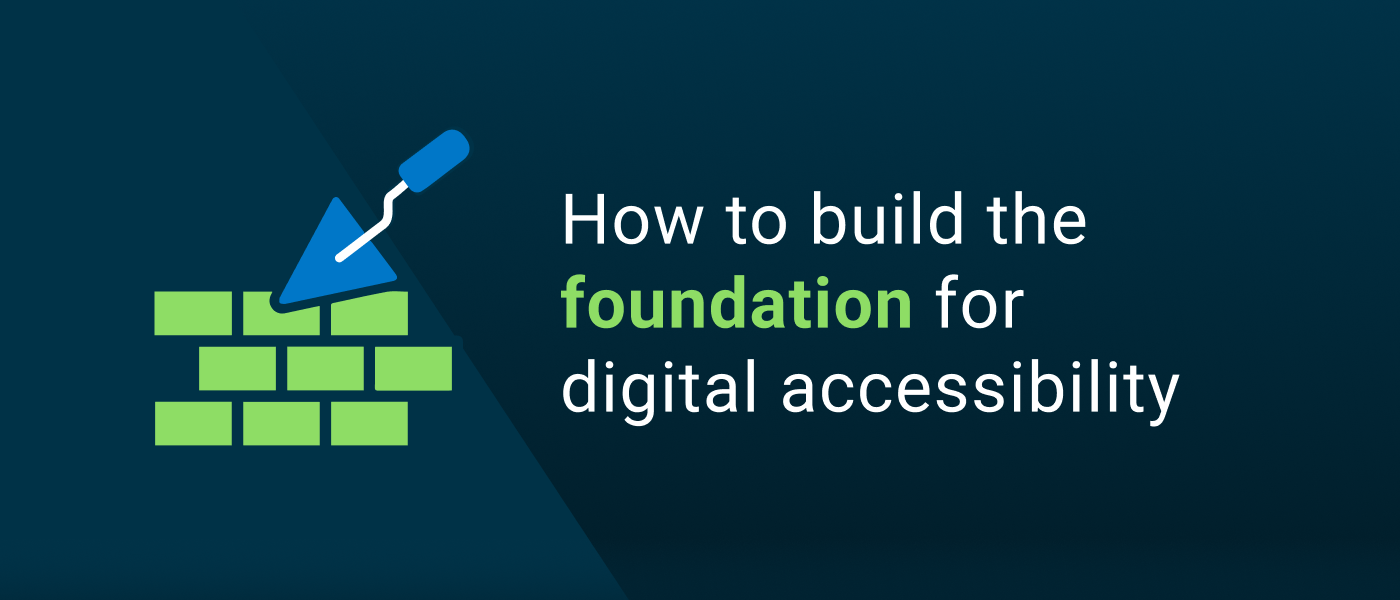A strong accessibility foundation is the most crucial component for building a successful accessibility practice at your organization, and everyone will need to be on board and engaged for the practice to take hold and succeed. There will inevitably be some thought-shifting that needs to take place and foundational principles that need to be understood and accepted. Over the years, I’ve advised all sizes and manners of organizations, and I’ve found that the following organizational principles need to be put in place.
In order to build the robust accessibility foundation needed to serve your end website users and adhere to compliance, your company must have:
- The inclination to practice accessibility
- The time to do the work
- Education and training to understand how to do the work
- Access to expert accessibility solutions to support ongoing work
- The automation and accessibility tools required to shift left and drive success
Before you can get started, each stakeholder needs to understand what these principles are, how they apply to their work specifically, and how to realize them across the company.
The inclination to practice digital accessibility
In this blog post, we’ll talk about the first principle and the three important actions that make a solid accessibility foundation possible across an organization:
- Obtaining executive buy-in
- Creating and enforcing an accessibility policy
- Running an accessibility awareness campaign
How to obtain executive buy-in
I’ve seen hundreds of companies practicing accessibility, and not a single one has made significant, sustainable progress without the backing of their C-suite. I cannot stress how important it is to make this happen. With that backing, accessibility will remain a priority through business ups and downs, leadership changes, acquisitions, mergers, and more. In other words, it will become a piece of the company’s fabric and culture.
Building the business case for digital accessibility
Your C-Suite will want to know the risks, opportunities, direct costs, and extended costs of the program before they approve. So, you’ll need to build the business case. Here are some of the actions you’ll need to take:
- Analyze your current risks and determine how an accessibility program can mitigate them.
- Detail the opportunities and business benefits. This means increased market share, improved brand reputation, reduced operational costs, legal and compliance risk mitigation, and more.
- Determine your direct costs, the internal hours needed to transform your organization.
- Frame out your extended cost: Who you will hire to help, the cost of accessibility tools, training, and education, and more.
- Conduct modeling to project the return on investment and determine your horizon to build out a sustainable capability.
Business benefits of accessibility
Market share. Being accessible increases your market share. People with disabilities have a disposable income of $500 billion in the United States alone. In market terms, that’s 24% of US citizens. Expand this to the disability community—friends and family of persons with disabilities—and that number jumps to 73% of US citizens!
Brand reputation. Demonstrating a commitment to accessibility aligns your company’s brand with social justice movements. Today’s consumers consider a business’s core value when they are making their buying decisions. A widely cited Harris poll recently concluded that more than 80% of consumers want brand values to align with their own.
Cost efficiency. Making your digital properties accessible decreases operational costs. You may be a multi-channel company with brick-and-mortar stores, call centers, a mail facility, and more. But your least expensive channel is always the digital one. To save on operational costs, it’s important to enable all of your customer base to use that channel.
Risk avoidance. Being accessible decreases the risk of complaints, demand letters, and lawsuits, as well as the expenses that come with them. Not being accessible can result in very public, very negative disclosures that harm your brand. There can also be significant financial consequences.
Raising these important factors addresses the things your executives care about most and are accountable for on a daily basis and will help them make accessibility a priority.
How to create and enforce an accessibility policy
Once you have executive buy-in, you must create the policy that will drive your internal organization. An accessibility policy (not to be confused with an accessibility statement) clearly lays out your path to success.
A good policy will:
- Identify all the stakeholders. Your stakeholders will include development, design, product owners, compliance, legal, procurement, budgeting, and more.
- Set your targets or scope. Examples of this might be achieving WCAG 2.0 A/AA compliance by a certain date or having no critical or serious issues and creating a backlog of minor and moderate issues by a certain date.
- Make the accessibility policy flexible. It’s important to increase scope and quality over time. Don’t immediately say, “This policy covers every piece of digital content out there,” because two things will happen if you do: 1) You’re going to fail, and 2) You’re going to immediately be in violation of your own policy.
- Don’t let the policy outrun your capability. Build the capabilities and the teams and ensure they have a chance to be successful before you hold them to the policy standard.
- Understand your audience and communicate professionally. You need to create a good first impression as you’re getting started, especially if accessibility is new at your organization. Good communication is also important as you work across departments.
- Have timelines and goals around enterprise approval. To convince your C-suite or create a policy, you need to have an actual timeline goal so that you’re holding people to making decisions so you can move forward.
- Take your roadshow to key stakeholders. Once they understand what you’re trying to accomplish, they’ll try to help you.
- Make accessibility easy and funded. Success happens when processes are efficient and effective, and the work is funded and resourced appropriately.
By following these principles, your policy will be written in a way that’s manageable now, and sustainable and extendable into the future as you drive toward your long-term objectives.
A key aspect of your accessibility foundation is accessibility governance
It’s also important to adopt a governance structure and a tool such as a tracking system. If you’re a large organization, there’s a 99% chance that you already have a tracking system that your company is using for enterprise risk management. If that’s the case, use that system. Also, you can reuse the policy structure from this system, so you don’t have to create everything from scratch.
Stakeholders also need to have periodic accountability discussions. For example, between development executives, senior business leaders, and the C-suite.
How to run an accessibility awareness campaign
Most of your employees are probably unfamiliar with how people with disabilities navigate websites and applications. An accessibility awareness program is a great way for people to fully understand what this looks like.
First, discuss what types of disabilities exist and how people might interact differently with your content. Next, give employees hands-on experiences with the assistive technologies people with disabilities use. This is always a “lightbulb” moment. Once people understand what types of disabilities exist and how people with disabilities navigate the web, discuss how everyone can start changing the way they do their own work and how to make your website and applications accessible to these assistive technologies.
This may seem like a very simple project—it isn’t. Accessibility education needs to be an ongoing and regular part of training for everyone in your organization.
Accessibility awareness activities
- Accessibility awareness labs. They can be either virtual or physical. Labs demonstrate how someone with a disability might use assistive technology to interact with the physical or digital world.
- Accessibility holidays. Coordinate communications with an accessibility holiday. Global Accessibility Awareness Day and International Persons with Disabilities Day are two major accessibility events.
- Ongoing and robust communications plan. Plan regular emails to promote learning for everyone and create a dedicated Slack channel. If you have one, partner with your organization’s disability employee resource group.
It’s very important for everyone at your company to understand how they can help with accessibility, but it’s especially important for designers and developers so they fully buy-in and don’t see it as a burden.
Risk management and accessibility: Keeping things on track
We’ve discussed how to talk about the business case for accessibility with your C-suite, how to create an accessibility policy, and how to teach people about the importance of accessibility.
In the beginning, you’re likely to encounter problems and pushback. Change is hard. One way to overcome this is by managing accessibility formally, with established project or change management processes.
Let’s do a very brief exercise on risk management to avoid or mitigate pushback.
A standard risk statement can be thought of like this: Due to X, there’s a risk that Y will happen, and if it does, the result will be Z.
For example, “Due to a lack of multi-year funding, there’s a risk that funding for subsequent years might not be adequate for the roadmap, and this would result in a failure to meet multi-year goals or a drop in quality.”
Other possible risks might include:
- Failure to get executive backing
- Failure to involve stakeholders
- A policy that is too strict and too fast
- A policy with no exception processes
- A policy that doesn’t track exceptions
- A policy that doesn’t assign accountability
To mitigate your risks, you’ll need to first prioritize risk management based on the probability of occurrence and the impact it will have. You simply can’t mitigate every risk that’s out there.
Then, do a risk session. Have stakeholders write down potential risks and classify them into topics, probabilities of occurrence, and probabilities of impact. You’ll be able to identify those things that you need to take action on first.
Here’s an example: Due to a failure to involve all stakeholders, teams are not allocating enough sprint time to complete the work, resulting in critical and serious defects going into production.
This is a risk that I see almost every single accessibility program deal with at some point or another. To mitigate a risk of this kind:
- Identify groups controlling product scope.
- Create a communications plan to revisit executive mandate and information.
- Conduct sessions with product owners and managers to discuss needs.
- Prioritize accessibility as a non-functional requirement.
- Make it easy by providing tools and automation.
- Measure outcomes, gamify, report, and reward.
Begin your organizational change journey now
Accessibility isn’t necessarily difficult, but it does take time to create organizational change. The most important thing is to get started now. Keep in mind that accessibility requires patience, persistence, and commitment.
The good news? Automated tools such as the axe DevTools browser extension can have a huge impact on your development team’s ability to get started immediately. So, go ahead and get a tool and find enthusiastic early adopters who really want to see change happen.
Let’s look at some numbers:
- Up to 67% of defects can be identified and fixed in design. This is the most effective and cost-conscious method.
- Every defect identified and fixed in development costs an average of $350 less than finding and fixing it during QA.
- Every defect identified and fixed in QA costs an average of $450 less than fixing in production
- Letting a defect get into production can cost up to $800 or more to fix.
When defects go into production, you have to worry about:
- Customers unable to use content
- Customer complaints and dissatisfaction
- Increased litigation risk
- Increased regulatory risk
- Damaged brand reputation
- and more!
If you scale these costs to thousands of pages and thousands of defects, you can see how critical it is to prevent defects as early in the development process as possible.
This is why it’s so important to invest in the resources your developers need to do the job right. Without proper education, training, coaching, and tools, conscientious developers will try, but they’ll struggle, and you’ll have poor results. Supporting them properly from the start is critical to saving development time and money, and for the organization as a whole to practice accessibility sustainably.
Build your accessibility foundation with Deque Systems
Embracing the steps I’ve outlined above is how you can build the foundation for digital accessibility. But remember, this is only the first step, and the work is ongoing. This is why I like to say that accessibility is not a product, it’s a practice!
Don’t navigate trying to build an accessibility foundation alone — let Deque Systems’ seasoned experts guide you toward a more inclusive, compliant, and user-friendly digital experience with our industry-leading accessibility solutions.
Schedule your free discovery call today and gain the confidence to take your accessibility program to the next level.


